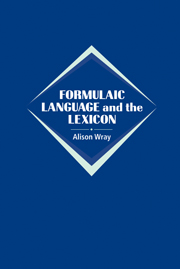Book contents
- Frontmatter
- Contents
- List of Figures and Tables
- Preface and Acknowledgements
- Part I What Formulaic Sequences Are
- 1 The Whole and the Parts
- 2 Detecting Formulaicity
- 3 Pinning Down Formulaicity
- Part II A Reference Point
- Part III Formulaic Sequences in First Language Acquisition
- Part IV Formulaic Sequences in a Second Language
- Part V Formulaic Sequences in Language Loss
- Part VI An Integrated Model
- Notes
- References
- Index
3 - Pinning Down Formulaicity
Published online by Cambridge University Press: 07 October 2009
- Frontmatter
- Contents
- List of Figures and Tables
- Preface and Acknowledgements
- Part I What Formulaic Sequences Are
- 1 The Whole and the Parts
- 2 Detecting Formulaicity
- 3 Pinning Down Formulaicity
- Part II A Reference Point
- Part III Formulaic Sequences in First Language Acquisition
- Part IV Formulaic Sequences in a Second Language
- Part V Formulaic Sequences in Language Loss
- Part VI An Integrated Model
- Notes
- References
- Index
Summary
Introduction
We saw in the last chapter that the identification of formulaic sequences in text is extremely difficult, largely because of the absence of any single definition able to capture all the relevant features at once. Various solutions to this problem are possible. One is to live with a definition that is, at some level, exclusive. This means that types of string which fall outside that definition are simply set aside, even if they seem to have something ‘formulaic’ about them. Many of the definitions that we shall review in this chapter do this either explicitly or implicitly. Another solution is to accept a fragmented definition or, to put it another way, establish a bundle of features, any or all of which a formulaic sequence may possess, but none of which is individually necessary. To date, this approach does not seem to be much adopted in definitions of formulaic sequences, perhaps because there is still a strong underlying belief that they are a single linguistic phenomenon (something that I shall dispute later). Two more favoured approaches are the closely related ‘prototype’ definition, in which an individual example of a formulaic sequence is identified with reference to one or more definitions which can apply strongly or weakly, and the ‘continuum’ type of definition, where subtypes of sequences are set along a scale from most to least formulaic. Finally, there is always the possibility of discarding all the definitions that rest on form, in favour of a different type of definition.
- Type
- Chapter
- Information
- Formulaic Language and the Lexicon , pp. 44 - 66Publisher: Cambridge University PressPrint publication year: 2002



